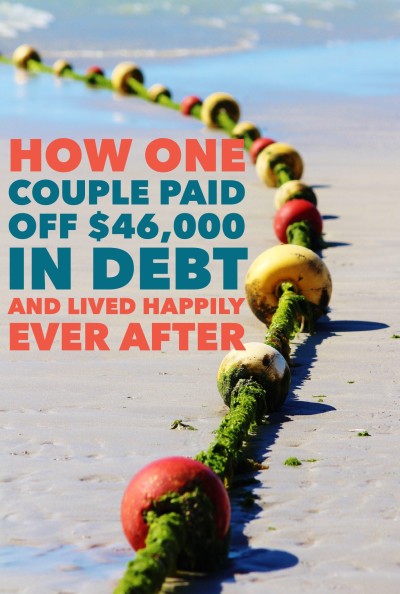He was 20 years old, living alone in a strange city. He didn’t know anyone. He was broke.
His checking account was empty. His savings account was nonexistent. His credit card was only $264 shy of hitting its limit.
He had a glimmer of hope, a faint light on the horizon: two of his friends would visit that day. He’d finally enjoy some companionship.
He promised to greet his friends at the airport. But just a few hours before their flight arrived, Bob’s car died.
****
His car didn’t even have the courtesy of dying while it was safely parked in a driveway. Nope, the car obeyed Murphy’s Law, sputtering as he drove near a crowded minor-league ballpark.
Bob felt like he hit rock-bottom. He heaved his vehicle to the side of the road, sat inside his two-ton paperweight, and wondered — what’s next?
****
Fast-forward to today: Bob and his wife Linda have paid-off $46,000 in debt. They just welcomed an adorable baby boy into their lives. (And they own a working car.)
How did Bob traverse from broke to bliss? He’s here to share his story in his own words. Afford Anything tribe, meet success story: Bob Lotich.
****
#1: Tell us about your journey. How did your 20-year-old self start building savings, paying off debt, and regaining financial footing?

For me, it required getting to the breaking point.
Like most 20-year olds, I thought I knew everything. I honestly thought I was good at managing my money. But I didn’t know what I didn’t know.
Getting to my breaking point made me humble myself and realize that there was some stuff I didn’t know.
From there I set out to learn.
I read every book, magazine, and website I could find about money management, and over the course of a couple years I developed much better money management habits.
#2: What was the first thing that happened after your car broke down? And what changes (if any) did you make in the next few days?
I still remember sitting in my broken-down car asking God for help. I knew that I was in big trouble and not at all smart enough to figure this situation out.
Like you mentioned, I had no money in my checking account and only had $246 left before my credit card was maxed. Miraculously, I was able to get my car towed to the mechanic and get my alternator replaced for less than $246.
As if that wasn’t exciting enough for me, the mechanic got it finished in time for me to go pick up my buddies from the airport. The next few days were the beginnings of my financial transformation, where I began soaking up information like a sponge.
#3: You and your wife have paid-off $46,000 in consumer debt. Congratulations! Let’s start at the beginning: How did you accumulate this debt?
When we got married I was still recovering from my past financial mistakes and she was in the middle of some mistakes. Together we had a lot of credit card debt, a couple car loans (on old cars), and student loan debt.
#4: What was your “wake-up” call?
My wake-up call began in the broken-down car, but during our engagement we committed together to living debt-free. We both could see the freedom that it provided and we were committed to reaching that goal, no matter what challenges and obstacles lay in front of us. We spent the next 3 years or so making lifestyle sacrifices in order to reach our goal.
#5: What were some of the biggest obstacles you faced while repaying your debt?
My wonderful wife was the big overcomer in my eyes. When we got married I had already lowered my standard of living and was already accustomed to making sacrifices. However, my wife hadn’t exactly made any changes to her standard of living. She was essentially spending about 140% of her income.
Once we got married, she instantly had to go from spending 140% of her income on clothes, movies, going out to eat, etc., to having about 5% to spend on those items. I could have never made that dramatic a shift so quickly — but she did.

#6: What helped the most during your road to debt-freedom?
Staying focused on the goal. It is pretty easy for me to stay motivated as long as I see progress towards the goal. I am patient guy and I can wait; I just need to know that each step is getting me closer to my destination.
#7: You write popular personal finance website, SeedTime. What inspired you to start writing about personal finance?
During this transformative period in my life I was just thrilled with everything we were learning and felt like I needed an outlet to share it. Starting a blog just seemed like the best medium to do that.
#8: You’ve been blogging about money for 7 years. You’ve presumably read thousands of readers’ stories, questions, and comments. What are some of the most common financial obstacles your readers have faced?
For most of us, we are our own worst enemy. I do get the occasionally email where someone is in a tough financial spot due to external circumstances, but the vast majority of them are self-inflicted.
We live in a society that makes it very difficult to remain content and most of us dig our own financial graves with unnecessary credit card spending. I see this over and over and so much of it comes down to just being able to say ‘no’ to ourselves. If we could all do a little better job with that, there would be a lot fewer bankruptcies out there.
#9: On the flip side of the coin — What are some of the most common ways in which people “get it right?”
I don’t see this as often as I would like, but I love getting emails from readers who consistently made good financial decisions for years at a time. They did it whether it was easy or difficult and refused to quit in the tough times.
And it is exciting for me to hear their success stories of how they paid off all their debt, are buying a vacation home, or are retiring a little earlier than expected – because they can. These people are who I look up to and help me stay motivated to make good decisions with our money!
#10: Some people reading this article are in the same position that you were in at age 20. They have a meager income, no savings, and a handful of debts. What advice would you give them?
Money management functions a lot like a snowball on top of a hill. It can roll in either direction, and the further it rolls in either direction, the better/worse it gets — and the faster it goes.
Each good decision we make adds more snow to the snowball (or pushes it back towards the right side of the hill). The more good decisions we make, the more success we see. But it is very important to remember that even if the snowball is going quickly down the wrong side of the hill, it can almost always be pushed back over the top to the correct side. It may take a lot of work, but it’s worth it!
#11: Several of my readers email me with questions about starting a blog. If you could distill your wisdom into a few short sentences, what would you tell an aspiring blogger?
Go for it! I believe everyone has something unique and special to share with the world. But as you go for it, strive to be yourself online and let your personality shine through. And don’t be afraid to ‘break the rules’!
Read His Books
Want to learn more about Bob’s path to debt-freedom? Check out his book How To Save Money: A 21-Day Challenge To Save $500/Month.
Interested in learning how he became a full-time blogger? Here’s his latest book, Pro-Blogging Secrets, which has (as of this moment) overwhelming 5-star reviews on Amazon.
